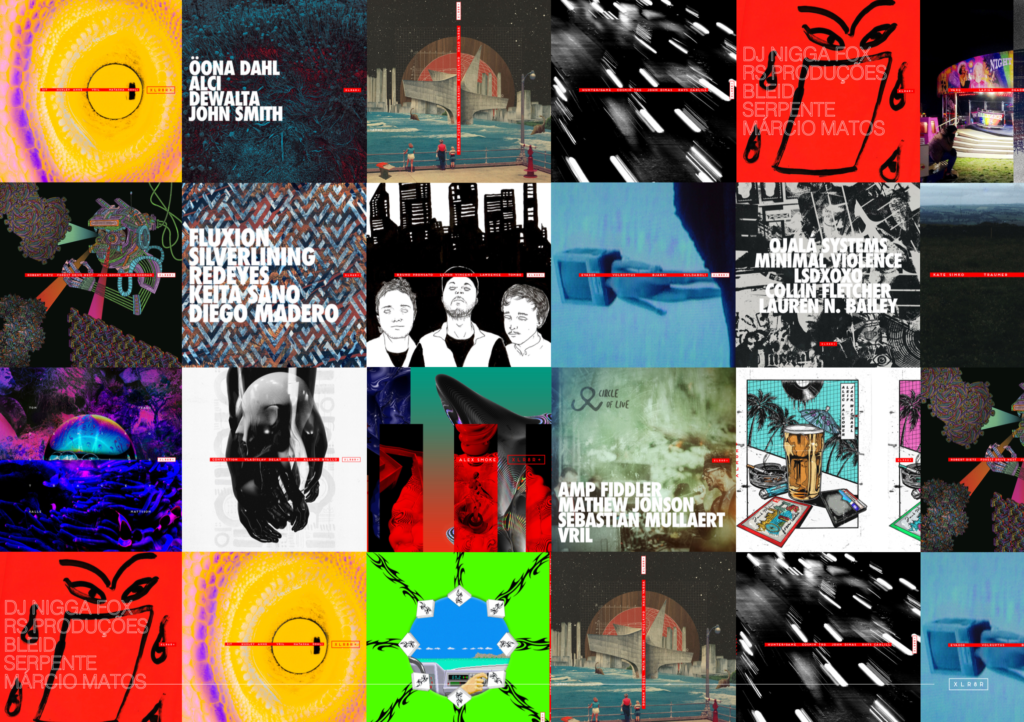Studio Essentials: Vlad Caia
A deep dive into the prolific Romanian artist's gear.
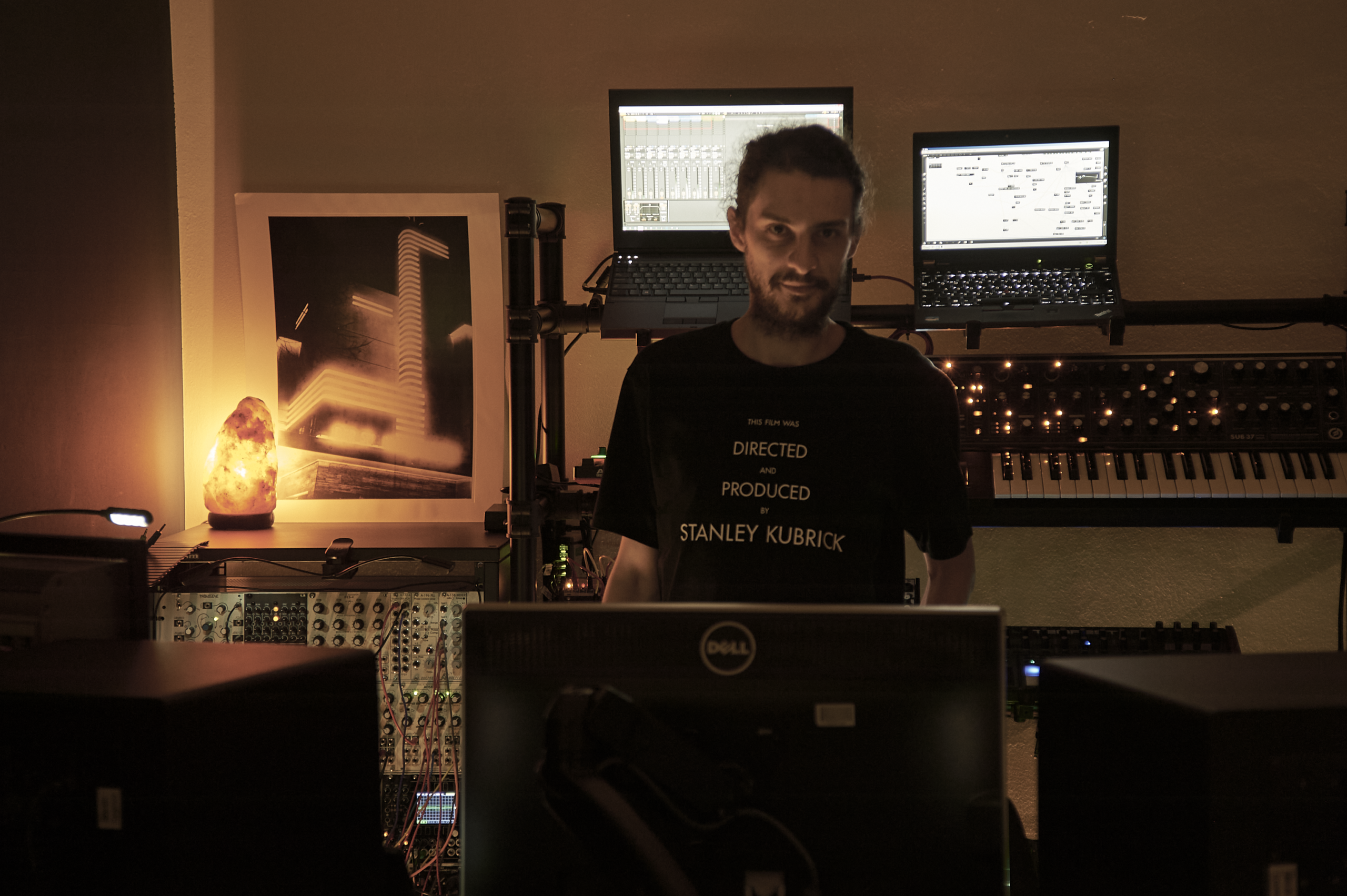
Studio Essentials: Vlad Caia
A deep dive into the prolific Romanian artist's gear.
Editor note: this feature was originally published in October as part of the Romania edition of XLR8R+. XLR8R+ subscribers get fast-tracked editorial, exclusive music downloads, art, mix and podcast downloads, and access to the member’s area where you can further exclusives and submit tracks and mixes to XLR8R. Find out more here.
In a Romanian music community known for trippy minimalism and mesmerizing loops, Vlad Caia has been an integral figure, but also one who has evaded the attention that’s landed on some of his peers. Outside of his solo work, he teams up with close friend Cristi Cons to run Amphia Records and as SIT, meaning Sideways Invisibility Theory. Alongside Mischa Blanos, an experiential jazz musician, Cons and Caia form Amorf, who recently released music via XLR8R+ alongside Priku, Sublee, Cosmjn, Dan Andrei, and Orli. Some of you will surely remember their sublime “Blending Light” being played by Rhadoo at Sunwaves.
Caia began his musical experiments in his early teens, equipped with only a MIDI sequencer and a keyboard. With the support of passionate musicians around him, ideas and soundscapes began to form, and he released his first works between 2007 and 2009, out via Next Dimension Music and Dinky’s Horizontal Records. He developed his sound while living in Norway, and he found himself drawn towards sound experimentation, eager to break away from the “standardized” rules of electronic music. This idea formed the basis for Amphia, launched in 2011 with an EP from Cristi Cons. Two years later, Caia released “Swan Lake,” an irresistible record on Pluie/Noir Recordings Division, and then Division, a two–part debut album across 2018 and 2019.
Having just released a new Amorf EP, Caia has continued to shape his Bucharest studio into a space capable of realizing an assortment of musical ideas that encompass jazz rhythms and orchestral arrangements, transcending the dubbed-out sonic grooves the city is recognized for. Versatility, he says, is the priority, and XLR8R decided to visit Caia to learn more about the tools and techniques that cater to this.
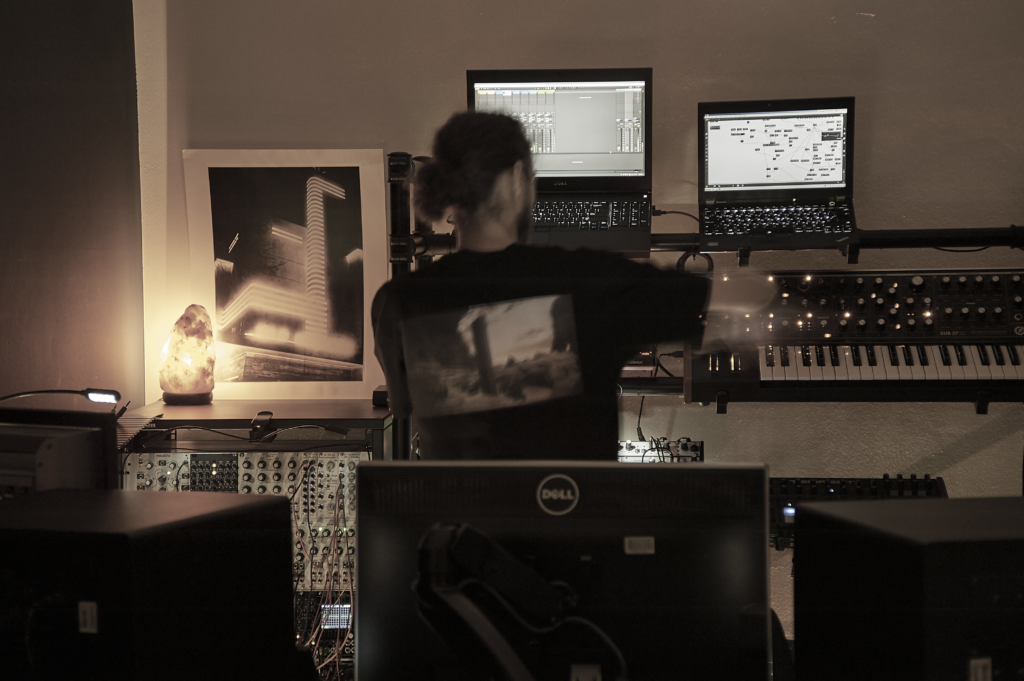
Over recent years, I have come to appreciate a more minimalist studio setup. I’ve realized that I work better when I have the bare essentials rather than lots of gear. Using fewer machines to their full potential allows for a more fluid workflow. It also allows for better experimentation, because you’re forced to use each device in ways that go beyond how it’s supposed to be used, and importantly beyond the magic “preset” buttons. By doing this, you begin to develop a sound that’s individual to you, which is important for every artist.
With this in mind, I rely on a hybrid system, which is to say I use both analog and digital instruments, plus three computers that run live effects for manipulation and mangling. These computers have a central role in my studio. Think of them like the beating heart, in that they’re where all the signal paths converge or diverge.
My main computer consists of a server unit housed in the main rack where all the audio/MIDI and digital signals are being received. This unit is used for multi-track recording of live improvised sessions, and it’s also used later for editing and arrangement work. Using the installed patchbays, I can also route audio to different instruments and modules directly from my DAW.
My second computer is a workstation notebook hosted in the instruments rack. I use it mostly for live loop recording and MIDI clips. I also use it to play virtual instruments and run audio effects, much like a guitar pedal. It can do anything I set it up to do, and its job is dependent on the nature of the track I’m working on.
My third notebook acts as an instrument of sorts, and it runs the Max/MSP environment. It’s more like a sketchbook where I try different patches. I synchronize these notebooks using Ableton’s LINK, via wireless to the server unit.
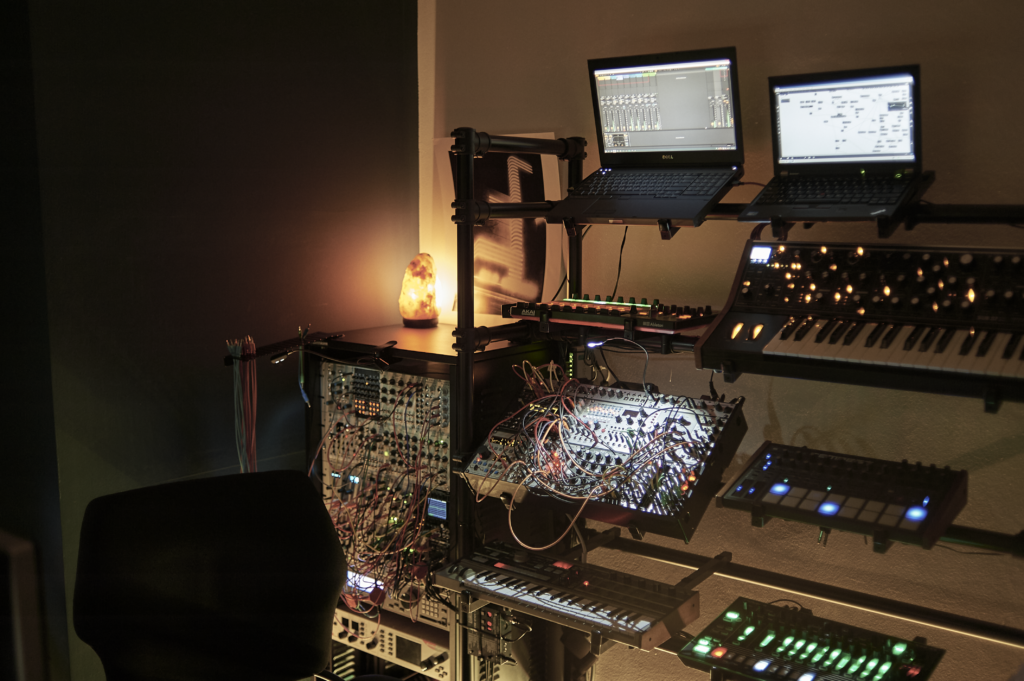
My recordings are all improvised. I program the stuff—my drums, synths, etc.—and then I click “record.” This leaves me with a recording of around 15 to 30 minutes, which I then need to edit. I usually end up doing lots of edits and trying different arrangements of each recording before it becomes a final track.
It’s important for me to take time with this. I’ll always test these versions on club systems and take mental notes. With these in mind, I check, re-check, and adjust the things that are obvious or need to be changed, like re-doing gain automation between the kick drum and the bassline, or working on some more EQing on the synth lines, or maybe taking out some reverb because it’s muddying the mix.
Spending hours on a track can create a bit of a trapped feeling in the auditory sense. It can skew your perception of how it really sounds, and it can also unknowingly move the track in strange directions from an arrangement and mixing point of view. Often these are directions that you didn’t intend for initially. I’ve been countering this by taking a few days off from listening just to clear my mind and have a fresh start. In the meantime, I’ll continue to work on something else entirely, or I’ll even just play around in the studio. Upon return, I have a different perspective on what works and what I’ve been focusing on way too much.
With this in mind, here are some of the key pieces of gear behind my music.
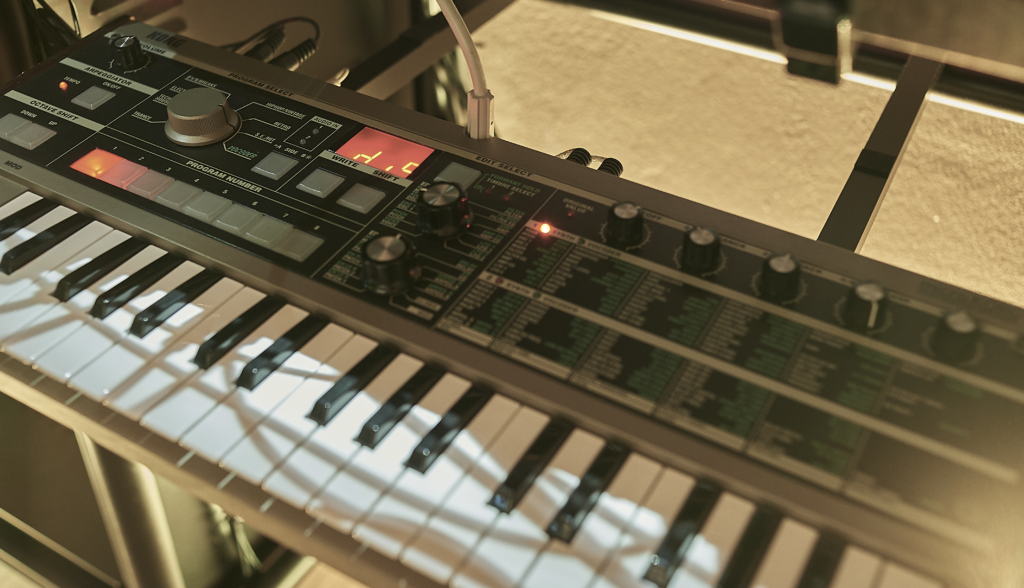
microKORG
I’ll start with the microKORG, which is the first synthesizer that I ever bought. I acquired it around 2007 while I was studying in Norway, from a local music shop.
It’s a curious little device with its little keys. It was meant to be just another virtual analog synth, just like any other synth from that era, but it has a sound that’s specific and discernible in my opinion; that’s what I really like about it. The bass can sound thick or boxy, if you want, and the filter is good enough to make it scream when turning up the resonance. The modulation matrix is extensive and has parallels with any modern modular system. It’s also useful if you’re travelling, because it can run on batteries!
I’ve been using this synth in my own projects, with SIT and also in Amorf. A notable use of this synth can be heard doing the bassline duties in a track called “Connection,” released in 2012. It can also be heard doing an arpeggio synth line in a SIT track called “Come Around,” which is included on Sideways LP, Part I, released in 2016 on Amphia Records.
“Come Around” was a fun track to work on, and I had such a blast using the delay effect that’s built into the microKORG. The synth creates a dynamic mood, especially while using the resonance on the filter coupled with the delay effect on the end.
You can also hear the synth on Amorf’s “Ouverture” from the album Blending Light released on Understand Live Series in 2017. The synth is present throughout the entire track, playing a repetitive sequence of two notes with the delay effect added.
To get the most out of the machine, I create my own banks of presets. It’s capable of harsh tones that work great for electronic music, or lush pads that you can use in the background. Did I mention that it also has a vocoder that’s very usable? Take it a notch further and use the vocoder as an external effects unit patched as an auxiliary send on the mixer. I was surprised when I ran sound through it!
The only downsides are the miniature keybed and the four-voice polyphony. It takes a while to get used to the small keys, and they can be especially tricky when you’re doing fast runs in a live performance. Being able to play just four voices at once takes some planning on the chords you want to hit. Playing elaborate chords one after another can mute previous voices, which is a nuance that becomes noticeable. However, you can cheat this by adding some delay and increasing the feedback. Doing it this way will sustain the previous notes a while longer!
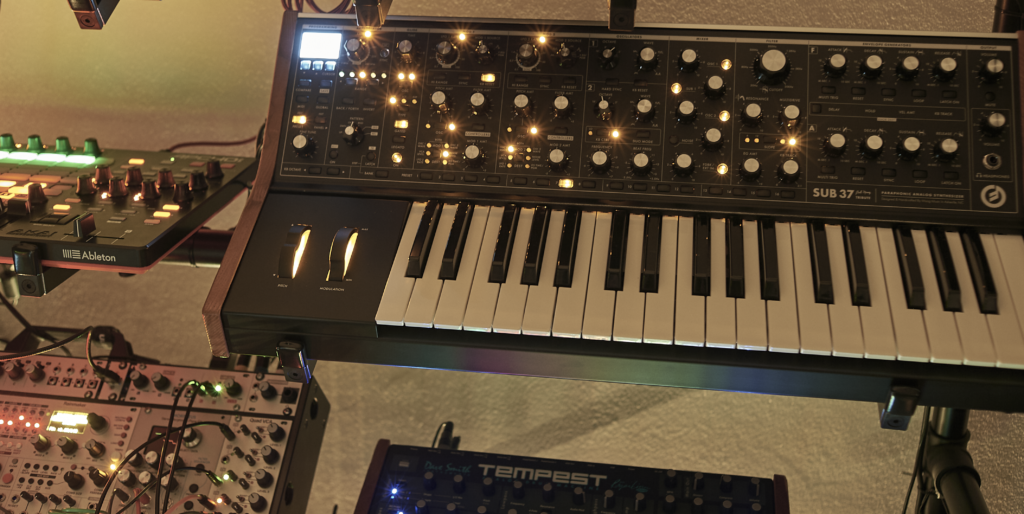
I was excited when news of the Moog Sub 37 started to pop up on discussion boards. Then I saw a NAMM 2014 video with Amos Gaynes and was blown away. This guy really knows how to present a product, and I actually believe he’s one of the lead designers of the synth.
The synth has many modulation possibilities and many types of arpeggio styles, which is handy for live performances. It also comes with its own sequencer and a beefy filter, as is tradition in the Moog world. I managed to buy one just as it hit the stores around 2015, by doing hourly page refreshes on Thomann.de. I was surprised at how heavy and bulky it was when I received it.
I’ve turned to the Moog Sub 37 a lot over the years. It’s present on every track of Amorf’s Blending Light album, responsible for the bass sequences, resonant percussion sounds, and also the noise swooshes. I also used it across my debut album, Division I and Division II, particularly on “Cluster” for the bass and synth lines, and “Border Patrol.”
This latter track was a bit more tricky to do because the Sub37 is paraphonic, which means it can’t play more than two notes at the same time because all the oscillators share the same signal path, and usually the filter will track only the highest note you hit.
To overcome this issue, for the bassline part, I recorded the same sequence twice with a slight variation of the notes, which meant I ended up with two tracks. I transposed one of the sequences one octave higher to complement the lower one and so it would create a full-bodied bass sound. The synth line comes on top of this foundation as a live improvised sequence.
I think this above example, with “Cluster,” is symbolic of what this machine can do and how it can guide you in terms of setting up modulations. I think it’s a really good bridge between a normal synth and the complicated world of patching a modular. It has CV inputs if you want to interact with it, and one of my favorite features is the audio input connection. I can run external audio signals through its filter. If you modulate the filter in a predictable or random way, it can create lots of surprising rhythmical patterns!
Some drawbacks would be the hefty size of this synth, and that fact that you can’t fold the control panel on its back. Even though I’ve built a custom case for air transport, it’s still cumbersome to carry from airport to airport for Amorf’s live shows!
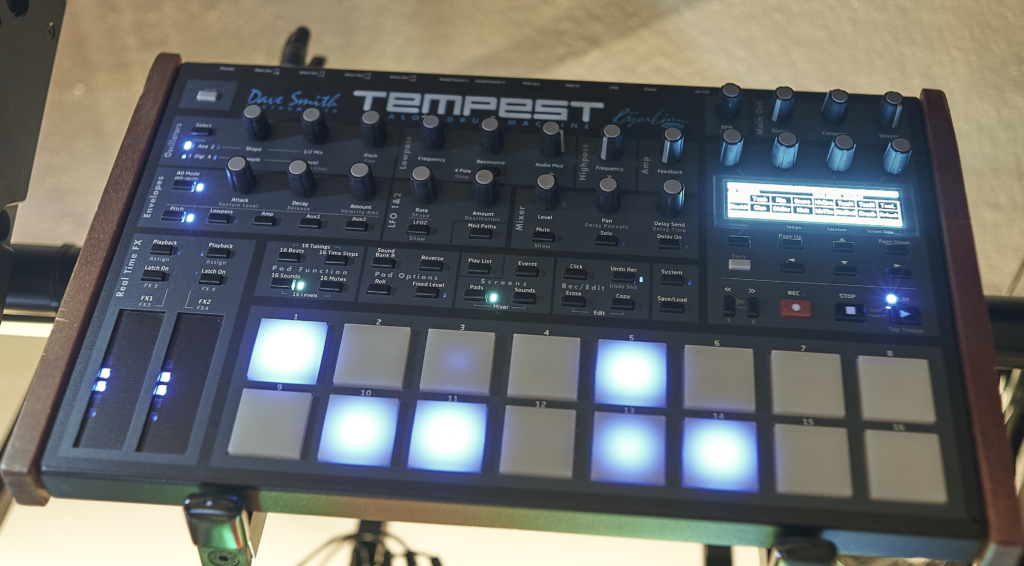
Dave Smith Instruments Tempest Analog Drum Machine
I rely heavily on the Dave Smith Instruments (DSI) Tempest for my percussion. It has its own character in regards to the sounds you can come up with, be it percussion or even synths. It’s an instrument that Roger Linn had also worked on, and being an Akai MPC 2000XL enthusiast at that time, it piqued my interest. I did some extensive research and decided to buy a used one from a friend around 2017.
One thing that still surprises me to this day is the built-in compressor and distortion effects. They’re both analog and can really destroy and mush everything together. This is especially handy as a sound design tool when reaching for those aggressive sounds.
The modulation possibilities are extensive and I often use a random LFO to pan the sounds in a sequence. I achieve lots of movement in the stereo field this way. It also has a peculiar “master” page where I can manipulate the entire collection of sounds I’m using in a sequence. For example, I can stretch the sounds or shorten them by modifying all the release envelopes simultaneously. I can create chirpy and glitchy bits with the switch of a button. I can later assign pitch parameters to a ribbon controller on the left side of the instrument and manipulate them on the spot, which is a trick I use during build-ups while recording a live session.
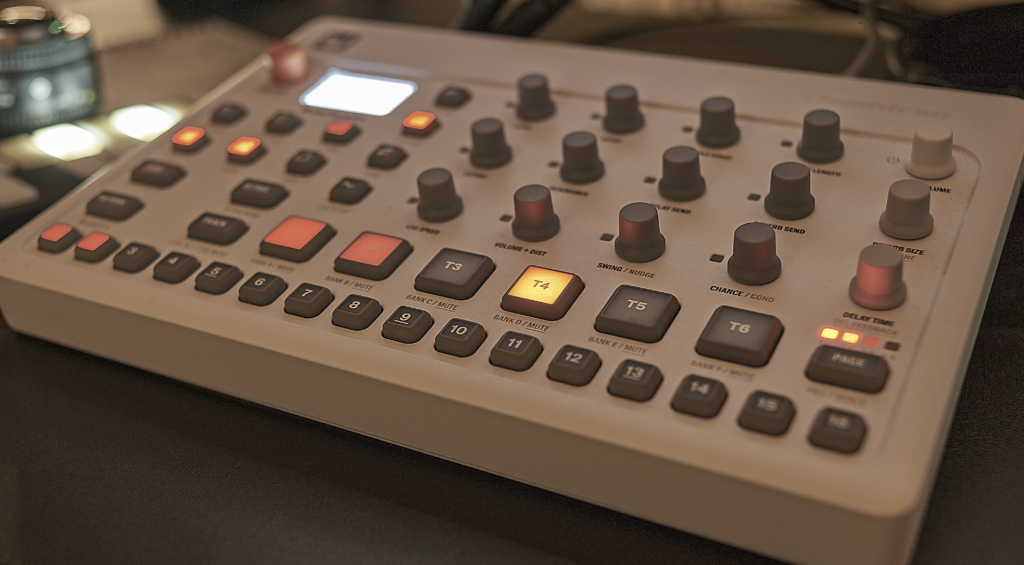
Elektron Model:Samples
I’ve had my share of samplers over the years. While I loved the way my AKAI MPC 2000XL sounded, I could never fit it in my setup partly due to the way it was designed. For deeper tweaks to what I’m working on, I would have to stop the unit from playing, ruining the workflow and getting the other instruments out of sync.
What I was looking for was an XoX type of rhythm machine with step programming, so I tried the Electribe ESX-1. It got noisy quickly and I could never achieve that punchy sound from the files I was loading from the card. It quickly became a popularity contest; the sound that came with the sampler sounded good, and no matter how hard I tried to load my own stuff it could never compete in sound quality!
It was then, in early 2020, that I came across the Elektron Model:Samples, a simple white box sampler with a what you put in it is what you get kind of attitude. It does a lot of things right, and it has become my mainstay percussion and drum machine. I love that I can modulate most of the buttons on its faceplate and that it can loop short pieces of waveforms called Wavetables. By sequencing bass or synth lines, I can expand my palette of sounds. Also, because I am a fan of using my own synthesized stuff, I’ve built a collection of modular percussion sounds specifically to be loaded on this drum machine!
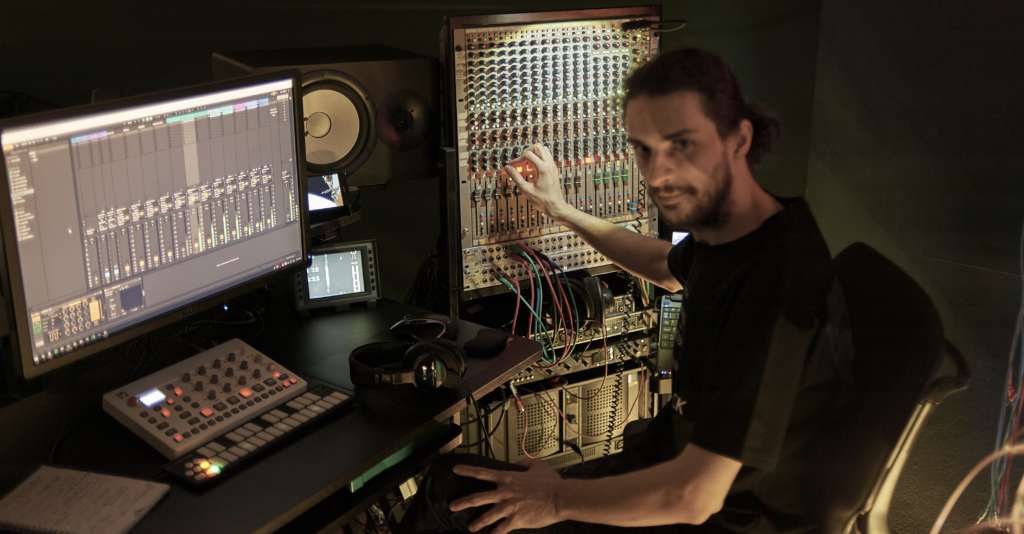
Modular System
My path to a full modular system started many years ago in software with the introduction of Native Instruments Reaktor. I still remember vividly trying this demo of version 2.3 and being so impressed that you could achieve these sounds on a slow, relative to now, computer. I started exploring the way an ensemble is built in this environment and the way these modules were interconnected, much like a real modular system. After some time, as computers became more powerful, these types of software became more accessible.
At this point, the Eurorack was still fresh, and there were far fewer manufacturers than today, so software was much more immediately available. But by 2015 things were moving at a quick pace in the hardware modular world. I actually really wanted to try the Nord Modular G1 first, and so I bought it on eBay. I had scoured forums dedicated to this synthesizer and downloaded around 8,000 patches that I could load onto it. It was an eye-opening experience and had the identical building blocks and modules you could find in a real modular. You had to use its own program to interact with it, but it was unfortunately unstable and would crash badly.
With these new lessons, I set out to build a system that could be flexible to what I need, be it a classical synthesizer architecture with extra modulation and sequencing, an external audio effect with lots of modulation, or for just patching it as a random drone generating source.
One of my favorite modules that I use often is the Orthogonal Devices ER-301 sound computer. It’s designed to work as a modular inside a modular, and I can set it up to any type of job, be it a sampler, oscillator, CV, or audio mixer. There’s an active community around this module and the firmware is constantly worked upon and improved with new features. For now, I use it as a sampler, so I’m triggering different loops and pads to play in sync with other synths. You can hear it doing glitchy drum hats in a recent remix I did for my friends from Alsi, “Scene Hero.” I also have it set up to use as a drum machine, if it’s needed. It’s perfect for traveling as you only need to take a small modular case and you pretty much have everything you need.
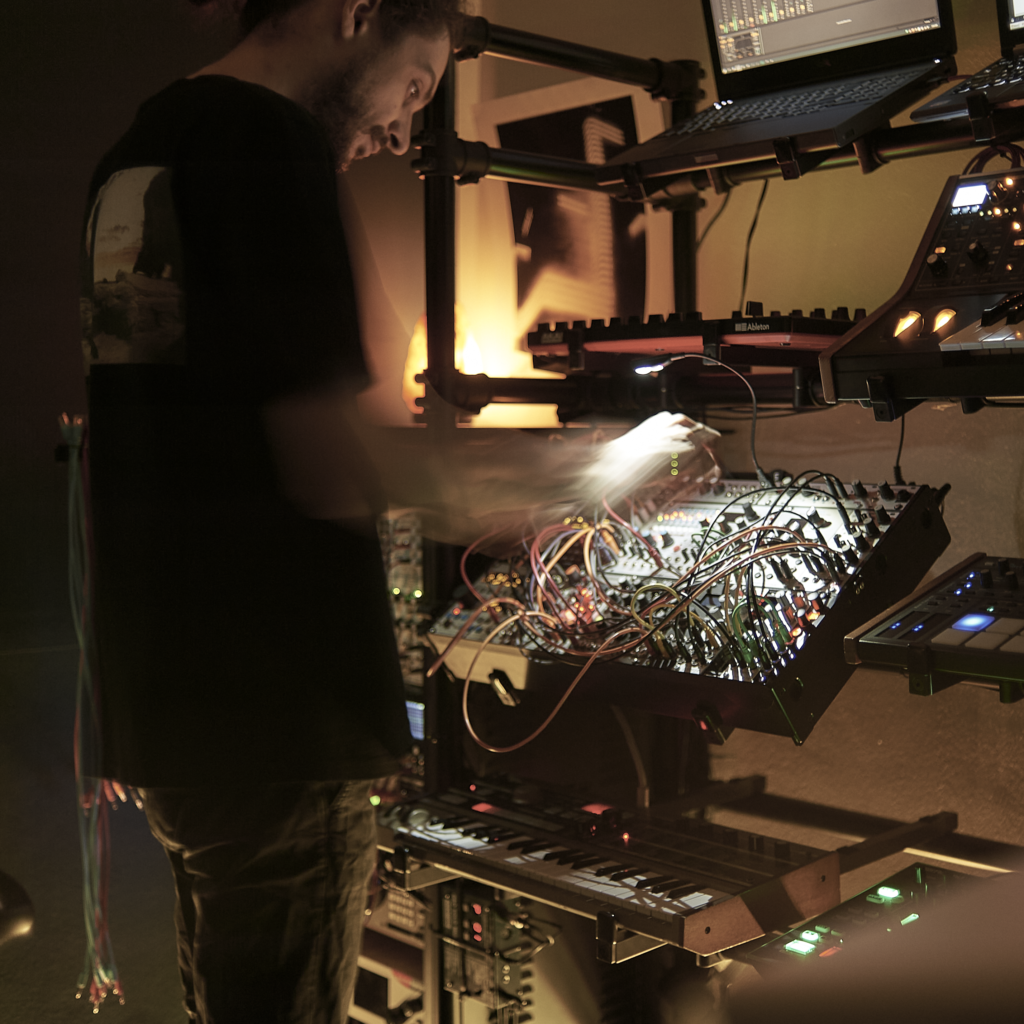
Intellijel Rainmaker is another favorite module I use extensively for sound design. I feed audio from my ER-301 sampler and modulate it to create extremely long delay lines by dividing the clock signal. For example, I can divide the 126 BPM by 16 and I end up with delays that change and react once every eight beats. If I change the pitch of these delays I end up with a sort of slow harmonizer effect.
Regarding VCA modules, I’m particularly fond of my Doepfer A-132-4. It’s compact and cheap, and you can change the VCA chips on the back. It has four inputs and two of those have different chips that I’ve installed. The sensitivity of each VCA can be easily trimmed on the back of the module. By adjusting it, you can distort the output volume into distortion territory, which is extremely useful for thick and solid bass sounds.
Make Noise Phonogene is another flexible module and I use it as a sample player and for live recording and playback of sequences. It’s my go-to module if I need to use bits of vocals or short bursts of percussion; stuff that is simple and that I have to do fast. I send these sources from my DAW and record it into the Phonogene.
From then on, I patch the module to play this sample in sync or at random times. I’m also experimenting on feeding it the entire output of my modular on set intervals of time. For example, every 32 bars it should record one bar of sequence and play it after 16 bars. After this is done, I can erase the memory and prepare for a new cycle, and so on. By doing this, I’m trying to achieve a controlled behavior of the sound that’s being synthesized.
Finding new modules is an intense process because I have to research exactly what’s needed at that time in my system. As of now, I’m looking for interesting sounding filters, both analog and digital, saturation modules, and utilities like the Expert Sleepers Disting modules, where you have lots of functionality in a small package.
You can hear some of the modules at work in “Expand,” released on Shahr Farang in 2018.
Support Independent Media
Music, in-depth features, artist content (sample packs, project files, mix downloads), news, and art, for only $3.99/month.
